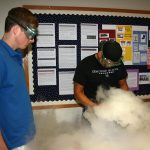John Richardson is not a chef, but he’s teaching cooking this spring—in a science course.
In “Mastering the Art of Chemical Cooking” Richardson, associate professor of chemistry, is teaching the practical applications of conventional (and some unconventional) cooking techniques to explore the philosophy of molecular gastronomy.




Ingredients of milk, cream, sugar, and vanilla don’t make much on their own. Add some liquid nitrogen and watch the magic (the chemistry magic) begin!
The course introduces students to a full complement of scientific ideas and chemistry, including properties of matter, atomic theory, chemical reactions, gasses, thermochemistry, intermolecular forces, kinetics, equilibrium, acids & bases, and biochemistry.
“Chemistry is all around us,” Richardson said, “and nowhere is this more evident than in the daily transformation that take place in our kitchens.
“By taking the topics perceived as difficult, wrapping them in a layer of the familiar, and reinforcing with hands-on demonstrations, students have the opportunity to come away with a better understanding of what chemistry is all about.”
From exploring why a very specific set of ingredients is a must for the perfect southern biscuit to figuring out why it’s so hard to get the right consistency for whipped cream and the real reason we cry when we cut an onion, Richardson is a molecular gastronomy enthusiast excited to share his passion for food and chemistry with students.
In class, Richardson and his students explore the molecules that make up food and their properties, discuss the facts behind the “universally accepted” proverbs of cooking and question their validity scientifically.
Work is not confined to the kitchen. Students read and discuss primary literature by authors ranging from Herve This, the co-founder of molecular gastronomy, to Nobel Prize-winning scientists Richard Axel and Linda Buck.
Students have been assigned an out-of-class project to test a family cooking myth. Students design their own experiments for the project, interpret their data, and present the results to the class—perhaps with some tasty demonstrations.
